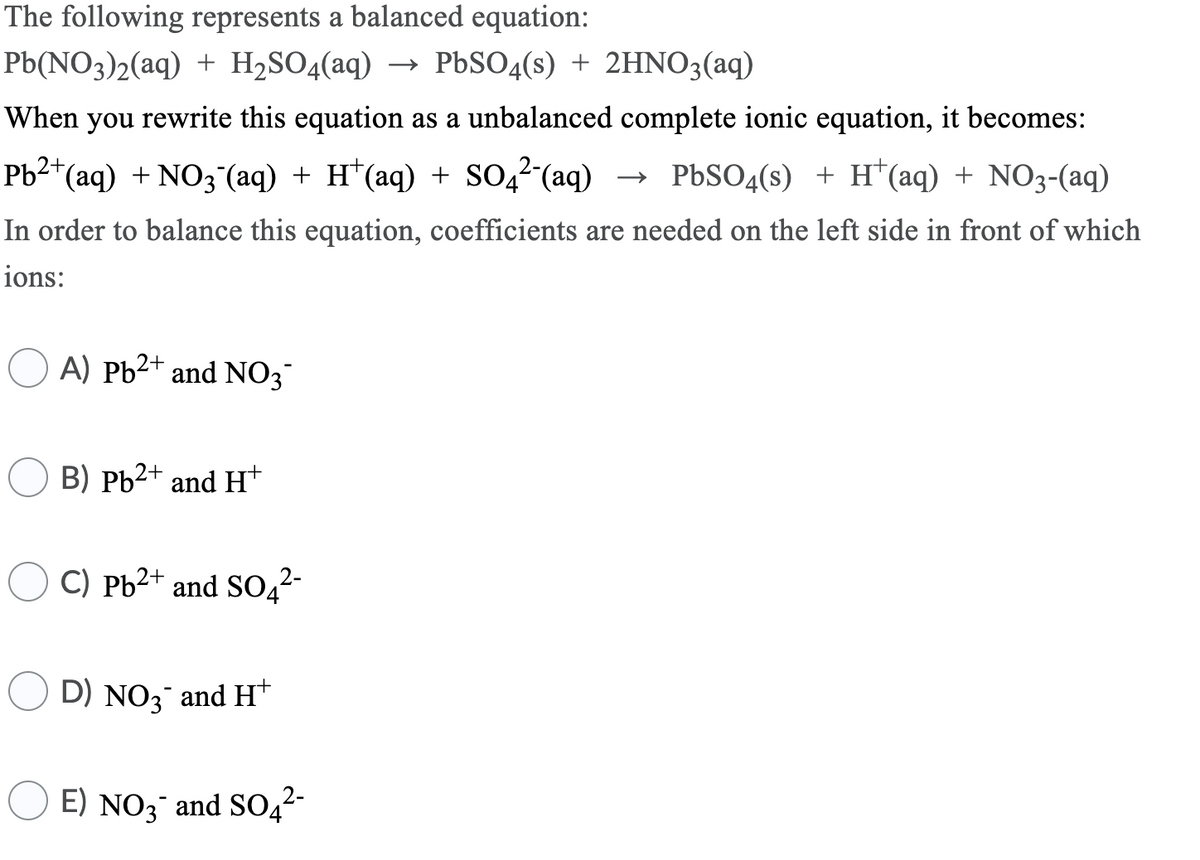ne following represents a balanced equation: (NO3)2(aq) + H2SO4(aq) PbSO4(s) + 2HNO3(aq) hen you rewrite this equation as a unbalanced complete ionic equation, it becomes: 2*(aq) + NO3 (aq) + H*(aq) + SO,2 (aq) → PBSO4(s) + H*(aq) + NO3-(aq) order to balance this equation, coefficients are needed on the left side in front of which ns: A) Pb²+ and NO3 B) Pb2+ and H* C) Pb²+ and SO4²- D) NO3 and H+ D E) NO3¯ and So2²-
ne following represents a balanced equation: (NO3)2(aq) + H2SO4(aq) PbSO4(s) + 2HNO3(aq) hen you rewrite this equation as a unbalanced complete ionic equation, it becomes: 2*(aq) + NO3 (aq) + H*(aq) + SO,2 (aq) → PBSO4(s) + H*(aq) + NO3-(aq) order to balance this equation, coefficients are needed on the left side in front of which ns: A) Pb²+ and NO3 B) Pb2+ and H* C) Pb²+ and SO4²- D) NO3 and H+ D E) NO3¯ and So2²-
Chemistry & Chemical Reactivity
10th Edition
ISBN:9781337399074
Author:John C. Kotz, Paul M. Treichel, John Townsend, David Treichel
Publisher:John C. Kotz, Paul M. Treichel, John Townsend, David Treichel
Chapter4: Stoichiometry: Quantitative Information About Chemical Reactions
Section: Chapter Questions
Problem 6PS: The formation of water-Insoluble silver chloride is useful in the analysis of chloride-containing...
Related questions
Question
Question is attached

Transcribed Image Text:The following represents a balanced equation:
Pb(NO3)2(aq) + H2SO4(aq)
→ PbSO4(s) + 2HNO3(aq)
When you rewrite this equation as a unbalanced complete ionic equation, it becomes:
Pb²*(aq) + NO3¯(aq) + H*(aq) + SO4²"(aq) → PbSO4(s) + H*(aq) + NO3-(aq)
In order to balance this equation, coefficients are needed on the left side in front of which
ions:
O A) Pb2+ and NO3
B) Pb2+ and H
C) Pb2+ and SO4²-
D) NO3 and H+
E) NO3 and SO,2-
Expert Solution
This question has been solved!
Explore an expertly crafted, step-by-step solution for a thorough understanding of key concepts.
This is a popular solution!
Trending now
This is a popular solution!
Step by step
Solved in 2 steps with 2 images

Knowledge Booster
Learn more about
Need a deep-dive on the concept behind this application? Look no further. Learn more about this topic, chemistry and related others by exploring similar questions and additional content below.Recommended textbooks for you

Chemistry & Chemical Reactivity
Chemistry
ISBN:
9781337399074
Author:
John C. Kotz, Paul M. Treichel, John Townsend, David Treichel
Publisher:
Cengage Learning

Chemistry: Principles and Practice
Chemistry
ISBN:
9780534420123
Author:
Daniel L. Reger, Scott R. Goode, David W. Ball, Edward Mercer
Publisher:
Cengage Learning

General Chemistry - Standalone book (MindTap Cour…
Chemistry
ISBN:
9781305580343
Author:
Steven D. Gammon, Ebbing, Darrell Ebbing, Steven D., Darrell; Gammon, Darrell Ebbing; Steven D. Gammon, Darrell D.; Gammon, Ebbing; Steven D. Gammon; Darrell
Publisher:
Cengage Learning

Chemistry & Chemical Reactivity
Chemistry
ISBN:
9781337399074
Author:
John C. Kotz, Paul M. Treichel, John Townsend, David Treichel
Publisher:
Cengage Learning

Chemistry: Principles and Practice
Chemistry
ISBN:
9780534420123
Author:
Daniel L. Reger, Scott R. Goode, David W. Ball, Edward Mercer
Publisher:
Cengage Learning

General Chemistry - Standalone book (MindTap Cour…
Chemistry
ISBN:
9781305580343
Author:
Steven D. Gammon, Ebbing, Darrell Ebbing, Steven D., Darrell; Gammon, Darrell Ebbing; Steven D. Gammon, Darrell D.; Gammon, Ebbing; Steven D. Gammon; Darrell
Publisher:
Cengage Learning

Chemistry: The Molecular Science
Chemistry
ISBN:
9781285199047
Author:
John W. Moore, Conrad L. Stanitski
Publisher:
Cengage Learning

Chemistry & Chemical Reactivity
Chemistry
ISBN:
9781133949640
Author:
John C. Kotz, Paul M. Treichel, John Townsend, David Treichel
Publisher:
Cengage Learning

Chemistry for Engineering Students
Chemistry
ISBN:
9781337398909
Author:
Lawrence S. Brown, Tom Holme
Publisher:
Cengage Learning